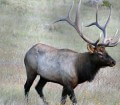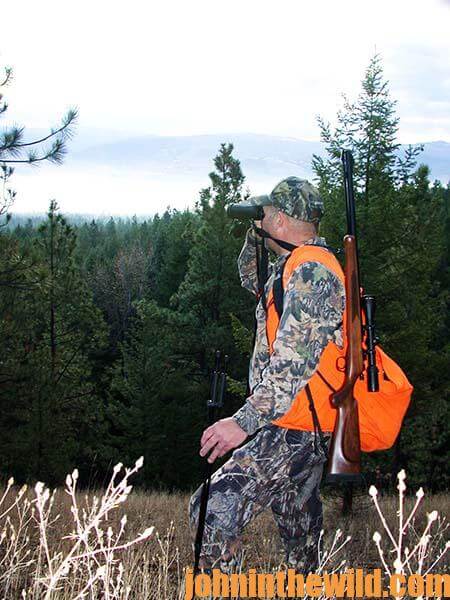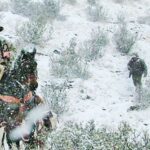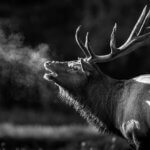John’s Note: Avid, nationally-known hunter Eddie Salter of Evergreen, Alabama, has hunted deer all his life and loves to hunt elk. This week, Salter, a pro staffer with Down-N-Dirty Outdoors Company www.downndirtyoutdoors.com, will tell us how he prepares for elk-hunting season. 
John E. Phillips: How often do you elk hunt?
Salter: I hunt elk every year if I can. I’ve taken a 6X6 and a 5X6 with my bow.
Phillips: What do you love about elk hunting?
Salter: Elk hunting is like hunting an 800- to a 1,000-pound turkey. You call elk just like you call turkeys. You have to be quiet, slip-up on them and change positions.
Phillips: Eddie, how do you prepare for elk-hunting season? There’s a lot of mountain climbing involved, right?
Salter: I’ve got a bad leg from two tree stand falls, so I can’t get in-shape like other hunters so. I try to walk twice a day and go to the local football stadium to walk up and down the stairs. Although I have to take my time, I’m gradually getting in shape by starting a regimen a month in advance. I walk a couple of miles through the stadium steps and repeat this routine in the afternoon. While getting in shape, I’ll wear the same Danner boots with knobby soles designed for hunting rocky terrain that I’ll wear on my elk hunt. Danner boots are different from the rubber boots I wear when I hunt turkeys or deer in the South. To prepare for elk season, not only do you have to get your legs and feet in shape, but you also have to break-in your hunting boots.
Phillips: Eddie, what do you use to call-in elk?
Salter: I start with a Mac Daddy bugle call to locate the bulls. I do the same amount of running and gunning during elk season that I do during turkey season. I like a bugle tube on the end of the Mac Daddy, which produces a very-throaty sound, like an old gravelly-sounding bull. This call is so easy to use and so deadly effective that a beginner or a young hunter can pick-up this call and use it to call-in elk. First I bugle a couple of times and keep moving and bugling, until I get an elk to respond by bugling back.
Phillips: What time do you start your elk hunt, Eddie?
Salter: I prefer to reach my starting place about 15-minutes before daylight breaks, and then I begin bugling. Oftentimes I’ll start bugling when I barely can see my hand in front of my face. Once I locate the elk, I’ll make the elk bugle back to me. Then I study the terrain to determine how I can get closer to the elk with a favorable wind for my cow call. As I’m planning my stalk, I try to reach a spot above the elk where I can cow-call to the elk.
Phillips: When you reach the place where you’ll call-in the elk, what call will you use next?
Salter: I prefer to use a cow call and a diaphragm call. I usually hunt elk with a bow and like to have the diaphragm call in my mouth, especially when a bull’s coming in for his final approach. When I’m hunting elk, I generally have one of my buddies with me who will set-up about 75-yards behind me to call elk. If there’s nobody behind me, I’ll call and wait for an elk to bugle back.
If I feel that the elk’s moving toward me, I’ll move away from my calling site and circle until I’m 75-yards closer to the bull. I want to take a shot with my bow when the bull passes by me moving to the spot where he thinks he’s heard a cow call. This way, all the elk’s attention is focused on looking for that cow and not looking to his left or right, where I’m waiting for my shot. As the elk comes in close enough for a shot, I’ll cow call with a diaphragm call to stop the elk. Then I’ll shoot him with my bow. When that bull hears the cow call closer than he’s thought it will be, he’ll stop to look for the source of the noise and think the cow has moved closer to him than she’s been when she’s first called. That’s when I release the arrow.
Phillips: A scent-elimination system is critical to your elk-hunting technique, since elk have such a keen sense of smell How do you use your scent-elimination products when you elk hunt?
Salter: Small things make the biggest difference when you get close enough to a bull elk to shoot him with a bow. Everyone knows you need to wash your clothes and take a bath with a scent-elimination product like Hunter’s Specialties Scent-A-Way and Scent -A-Way Soap. However, most people forget to protect the towel they use to dry off. Think about it for a minute. If you get into the shower and clean yourself from head to toe with Scent-A-Way hair and body soap, step out of the shower and dry off with a towel that’s been washed in scented or perfumed soap, that towel’s odor is applied to your clean body. So, wash the towel in Scent-A-Way Laundry Detergent, and put it in a Scent-Safe Bag. Now each time you get out of the shower, you’re drying off with a scent-free towel.
Too, I’m really conscious of my watchband. Most people have leather or cloth watchbands. But I wear a rubber or a plastic watchband, because it doesn’t catch and trap odor like a cloth or a leather band does. After I get out of the shower, and before I put on my watch, I spray-down my watchband with Scent-A-Way Advanced Formula Spray.
Many hunters forget about their boots. I leave my boots outside, away from camp, because if you wear your hunting boots inside camp, they’ll pick-up all the odors in the camp house. When I’m finished hunting for the day, I take off my boots, hose them down with the Scent-A-Way Advanced Formula Spray and leave them outside, until I’m ready to hunt the next morning. Then I’ll wear flip-flops or any other type of slip-on shoes from camp to my boots. I’ll wipe my feet down with Scent-A-Way Field Wipes, take my hunting clothes out of my Scent-Safe Bag and put-on my socks and boots. Too, I always spray-down my pack and my bow release with Scent-A-Way spray before I begin a hunt.
I don’t carry my wallet with me on elk hunts. I put my driver’s license, hunting license and elk tag in a Ziploc bag, push the air out of the bag and place the bag in my hunting shirt. Most people fail to realize that their wallets probably never have been washed. Therefore, they contain a massive amount of odors that have accumulated for several months or years. So, if you put the wallet in your hunting pants, you’ll have a super-charged, odor-emitting wallet killing your hunt when an elk comes in close enough to smell you.
To be completely scent-free and increase your odds for taking an elk, be conscious of the little things you can do to stay scent-free. I carry a bottle of scent-free spray with me in my daypack. Then if I sweat or have any problems staying scent-free, I’ll take out that bottle of scent-free spray and spray myself and my products whenever necessary. Most hunters don’t realize that regardless of how well you can call-in elk, if you get the bull to come in close to you, and he smells you before he’s close enough for you to take a shot, you still won’t get your elk.
Use scent-elimination products to keep yourself and your gear as scent-free as you can when you’re hunting that bull of a lifetime. Elk hunting is fun, and taking a big bull elk is even more fun, but spooking elk because you’re not scent-free is no fun at all. When I’m preparing to go to elk camp, I make a list of the equipment and the strategies I’ll use to ensure I’m as scent-free as possible every time I’m in elk country.
To learn more about elk hunting get John E. Phillips Kindle Books “PhD Elk”, “Secrets for Hunting Elk”, and “How to Find Your Elk and Get Him in Close” Click here to get these books.
About the Author
John Phillips, winner of the 2012 Homer Circle Fishing Award for outstanding fishing writer by the American Sportfishing Association (AMA) and the Professional Outdoor Media Association (POMA), the 2008 Crossbow Communicator of the year and the 2007 Legendary Communicator chosen for induction into the National Fresh Water Hall of Fame, is a freelance writer (over 6,000 magazine articles for about 100 magazines and several thousand newspaper columns published), magazine editor, photographer for print media as well as industry catalogues (over 25,000 photos published), lecturer, outdoor consultant, marketing consultant, book author and daily internet content provider with an overview of the outdoors. Click here for more information and a list of all the books available from John E. Phillips.












